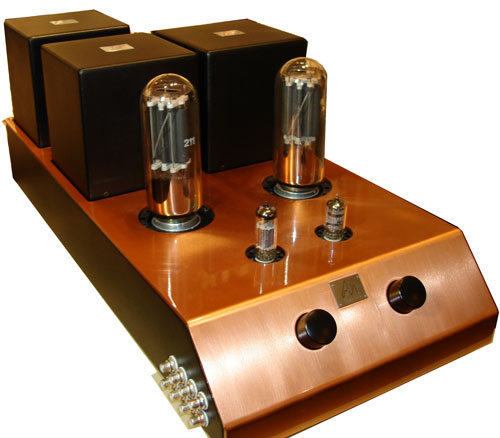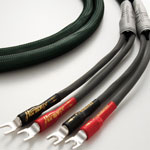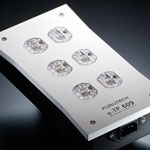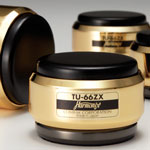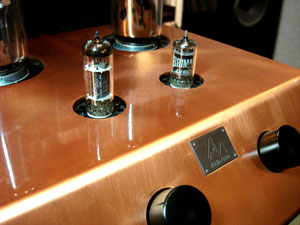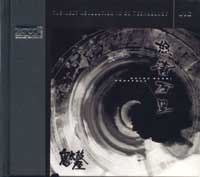To help exploit the potential of the Ongaku as much as possible, 47 Laboratory’s PiTracer CD transport served in this review as the reference source in the respective company of Audio Note’s own $65k DAC5 Signature, the $34k DAC5 Special and Wadia’s $10k 27ix v3.0 Decoding Computer. The AN DACs were rotated with the PiTracer from it’s RCA digital output via Combak Harmonix HS-102RCADG “Harmonic-Strings” RCA digital cable, while the Wadia utilized Analysis-Plus’ Silver Oval BNC digital cable via the PiTracer’s BNC output. Audio Note’s own 42-strand, pure silver litz Sogon™ interconnects provided reference interconnection.
|
Combak Harmonix HS-101 SLC |
Furutech e-TP609 |
Furutech Power Reference III |
Combak Harmonix TU-66ZX |
Audo Note’s own bi-wired Sogon™ LX speaker cable provided reference speaker cabling, while the Combak Harmonix HS-101 SLC “Sophisticated Listener’s Choice” single-wired cable served single-wiring speakers. CDs providing some of the most revealing listening impressions were by First Impression Music and JVC’s XRCD’s. Furutech’s marvel in AC waveform preservation, the GC-303 compound-embedded e-TP609 AC Director, and two of the Power Reference III AC cables powered the respective DAC’s when either the DAC5 Signature or DAC5 Special was in use.
Deployment of the Combak Harmonix tuning feet took place in the latter half of the review period, during which three of the adjustable TU-66ZX “BeauTone” tuning feet supported each AN DACs.
Audiophile recordings played a pivotal role in my experience of the Ongaku. For just as it is with movies and paintings that seek to show us certain angles of reality or layers in imagery that we don’t see in normal circumstances, the Ongaku’s rendition of meticulously produced music also shows us a level of sound ingrained to instruments that we seldom get to appreciate. Only now that the live instrument along with its surrounding environment is removed from our sensors are we able to focus our waking consciousness onto a particular sensory input; and the textures and tonality of instruments from high-quality recordings as produced by the Ongaku/AN-E SEC Signature hijacked my imagination completely.
Richard Nash, Audio Note’s web guru, is fond of the AN saying that goes, “one watt in one meter can kill you”. He meant to illustrate the ability of Audio Note’s systems of SET amplifiers and high efficiency speakers to play at insanely loud level with no compressions or distortions of any kind. Though an Audio Note speaker user for some time, I have never driven my 95dB, biwired AN-E SEC Silver with heavy-metal music like Peter does to the inhumanly high level during every Show. And he even drove the Ongaku as a power amplifier with the 3-chassis M10 preamp at this past Californian VTV. Peter was of the opinion that a preamplifier was nevertheless essential to supercharge even the Ongaku to reenact full dynamic envelope that is crucial to recreating a musical waveform faithfully; and his M10 became the natural candidate for its level of finesse. It was a sight and experience to behold.
In my listening room, with most loudspeakers positioned no further than 11 feet away from my ears, constant sound pressure arriving at my position during normal listening would reach 88dB+, while dynamic surges might hit 95dB. For loudspeakers with 91dB+ efficiency, a 25Wpc amplifier will drive those speakers to over 95dB with ease. In the particular case of the $12k, 100dB, single-wired MaxxHorn Immersion, even though it is the only pair of speakers being placed 15 feet away, its startling efficiency probably consumed only one or two of the 25 Ongaku-watts to produce the highest dynamic peaks.
Not too dissimilar was the case in which the Ongaku was driving the $19,000, 95dB/8Ω, tri-wired Tannoy Churchill Wideband, producing strikingly dynamic, climactic symphonic passages via its 15-inch Dual-Concentric™ driver.
Thus, by virtue of its shocking efficiency, the Ongaku-compelled MaxxHorn not only attained a new level of dynamic prowess never realized via any other amplification, the 6.5-inch, French PHL 1240TWX-equipped horn Texan produced the most spectacular tonal sophistication yet, and was completely transformed in the company of the AN. This time, the lone Japanese fue amidst a subtle taiko accompaniment in JVC’s Ondekoza XRCD2 in track 6, “Yuki no Ashita” was endowed with a rich texture and a surreal lightness, reinforced by traits of miniscule turbulence within the wooden flute.
The large Tannoy as driven by the Ongaku, on the other hand, revealed both a newfound subtlety as accompanied by such masterly flexing of dynamic muscles that was summarily atypical of what I’ve come to rely upon as the speaker’s performance threshold. The congregating drumming efforts on the quadruplet of taiko’s in the same JVC XRCD2’s first track, “Tou-Tou” (trans. The Pounding Wave) emerged as the most full-bodied to date, resplendent in the spectacular clarity of contrasting pitches as dictated by the varying forces applied by players.
- (Page 1 of 2)
- Next page →
